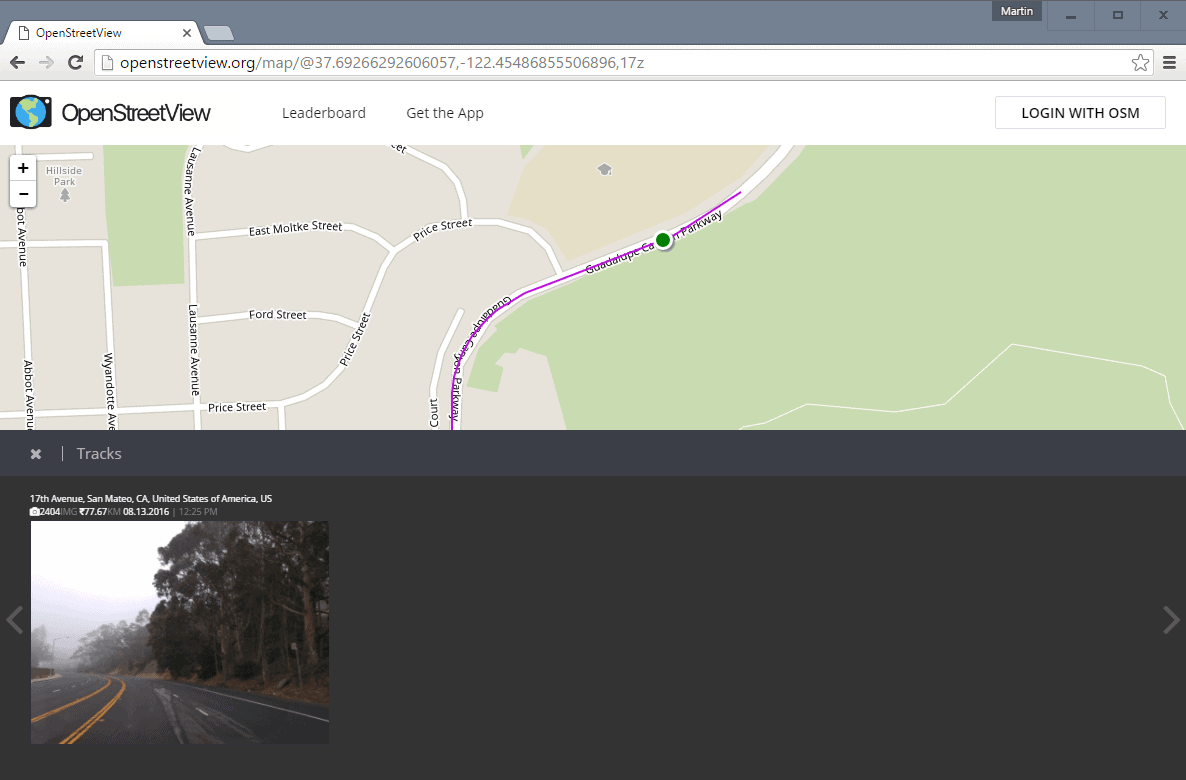OpenStreetView launches

OpenStreetView is a free crowd-sourced service by OpenStreetMap that offers street imagery that users of the service push to it while using it.
OpenStreetMap is an open source alternative to Google Maps, Bing Maps and other mapping services. The new OpenStreetView however works different than services like Google StreetView despite the naming similarities.
The service uses imagery that users of it are providing instead of capturing street views using company cars in all regions of the world.
This means that you won't get a full view of a street, but only image captures. Also, the service does not cover all areas yet which means that you may not get imagery in many areas around the world.
That's going to change though when more and more users start to use it and push recorded images while driving to OpenStreetView.
The approach has two advantages over comparable services. First, you may get multiple shots of the same area and not just one. Second, and that is related to the first, shots are taking at different dates which means that you get to see an area at different times.
Also, the data may be more up to date because of the approach. If Google or Bing want to update the data, they need to get cars to move around in the area again to do so. It happens that street view data is severely out of date because of this.
While this may also happen with OpenStreetView data, there is at least a chance that this won't happen if a driver happens to drive around in an area regularly.
You can load OpenStreetView in your browser. The map highlights all areas with street imagery in pink, so that you know where imagery is available and where it is not.
The coverage of San Francisco is particularly good already, but you will notice imagery in Europe as well already. This is limited to highways and interstates mostly though right now. You may also notice that some imagery is upside down. This is caused by users not paying attention to the position of the smartphone.
Mobile apps are provided for Android and iOS that users who want to contribute can use to create imagery and push it to OpenStreetView servers so that they become available to all users of the service.
Watch the following video that provides you with additional details about OpenStreetView
Closing Words
OpenStreetView is an interesting service that crowd-sources street imagery. The approach is the only feasible solution for services that are not backed by companies with multi-billion Dollar budgets.
While coverage depends largely on users, OpenStreetView may come to a point eventually where its imagery is superior to competing services thanks to it being fresher.





















@Tom Hawack
Someone ###### ##.
I think that all photos taken in the boundaries of the road itself should be of imagery facing in the direction of the flow of traffic, anything off the road itself however, I think, should by fair game, I say that because imagery of the storefronts could prove itself useful as well, again, as long as it is not taken from the road itself.
If the map shows Road1 as that of the image(s) then the images must show Road1, not Street1, even, IMO, if the image was taken from Street1
There is nevertheless the eternal problematic of the reference : if a picture taken from Area1 shows Area2 must the picture be located as the position of the photographer (Area1) or as the position of what has been pictured (Area2). The GPS approach is of course the location of the photographer, which may be far from was has been photographed, especially with a zoom. If I film the Statue of Liberty from the Empire State Building must I reference the picture Statue of Liberty or Empire State Building? IMO as the Statue of Liberty : we’re not investigating a crime we only want a map to show the pictured area.
Concerning the Champs-Elysées in Paris the error lets no place for doubt since what we see on the map is the avenue and what we see on the pictures are side streets which could not have been filmed from the avenue, so even a GPS argument is meaningless in this case.
###### ## = really ok (ko?)
nice idea, I wish them well
London had very littl coverage but guess its early days
checked site on my netbook (small screen) rather annoyingly the close picture X was almost completely hidden under the zoom controls, they might want to separate those by a few more pixels on the vertical axis
It would have been nice if this concept could have been integrated directly into openstreetmap.org
One of the aspects that I really liked about this initiative is the recognition function that this platform provides, those who contribute to openstreetmap.org know that acquiring on-sight references and then editing those references to the site can be a fun yet painstakingly long process, anything that would make the map editing process more automated would most certainly come as a welcomed relief to contributors.
There is an app for iOS titled ‘OsmAnd DVR’ that offers features similar to the ones in the app shown in the video.
Doesn’t there need to be an app to pull together:
– the photo
– the location
– the direction the phone is facing
– the time of day (so that day and night photos aren’t mixed up)
No-one am I gonna be adding the phone orientation manually, or sorting through all my photos to find which ones were meant for upload to this service. They need apps before the idea goes cold.
After all that, they can think about implementing a photo-transition technology, but they need the data first, while the iron is hot.
Well, and when is an “open source project” implanting a chip in our children at birth so that we can follow them in real time all over these streets?
That is such a good idea. It will make genealogy so much easier in 100 years. Thank you.
I prefer memories to skeletons and even to cryonic preserved meat …
Implant it on our lovers instead! (so that they don’t meet while I’m there, of course)
That’s good news. New, needs to be polished though. Just had a look for street views for Paris, Champs-Elysées and what was displayed were side streets to the famous avenue, not the avenue itself. But the “Place de la République” (Paris as well) displayed images in accordance with the map. (Yeah, Paris, because I know the place a bit).
What needs to be updated on another hand is indeed as noted by the article some (many) Google Street Views, because if it understandable to have 10 year-old images of a small village it remains puzzling to have nothing younger when it comes to JFK Intnl’ Airport for instance.
It’s a good start. Images are small and there isn’t panoramic viewing of course. Another approach than that of Google Street View. Complementary.